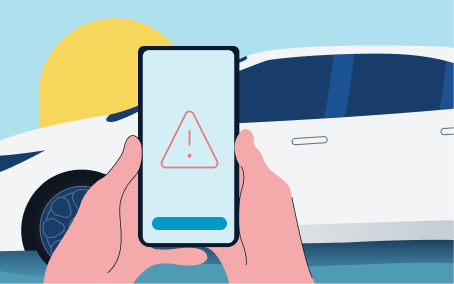Car damage detection is used in the automotive industry to ensure vehicle safety, avoid fraud activity and improve consumer experience.

What is Car Damage Detection?
Car damage detection is the process of examining a vehicle for any internal/external damages and assessing its overall condition. A Car Damage Detection system is a complex combination of Machine-Learning algorithms that are integrated with Pattern Recognition and Computer Vision systems to detect any physical anomalies visible on the vehicle. This digital process encompasses a variety of sensors and proactive technology that is then used to capture images and identify any part of the vehicle that has sustained damage.
The procedure of the system can be broken down into three parts:
1. Capture Image
2. Recognize the Vehicle and Elements
3. Detect Damages
Many systems judge the damages and assess their level of severity as well, hence allowing the user to identify the costs they would be required to bear. Focalx is an example of this feature. Their Car Damage Detection System is equipped with a feature that assesses the severity of the damage after it is identified. This process is recorded in the reports the user receives after the examination is completed.
Why is Car Damage Detection Useful?
Car Damage Detection is useful to ensure a specific level of financial and physical maintenance of the vehicle. There are two primary reasons why car damage detection systems are useful in assessing the vehicle’s condition.
Insurance Value
Many companies that provide insurance for automobiles use Damage Detection Systems to assess the level and severity of physical damage the vehicle has sustained. This allows them to hence provide funds to the driver according to the extent of the damage – especially after an accident.
Maintenance of the Vehicle
Damage Detection Systems are able to identify the wear and tear a vehicle has sustained efficiently, and hence allow for these damages to be detected early on. This is especially useful for car inspection companies that handle fleet or handover inspections as it allows them to prevent more significant damage and costly repairs.
What are the Applications of a Car Damage Detection System?
In the automotive industry, Car Damage Detection Systems can be applied in a variety of sectors. From improving vehicle safety to management of fleets, these applications include:
Vehicle Safety
Maintaining safety standards is an integral part of car manufacturing. The application of Damage Detection Systems in this sector is an important way of ensuring that both, the vehicle’s condition and the driver’s safety are ensured. These applications include:
Damage Examination
Many repair shops use damage detection systems to assess the extent of the damage. These digital systems are powered by technologies like Pattern Recognition and complex Machine Learning models and are equipped to identify any damages the vehicle has sustained over time. This allows the manufacturing companies to determine the required repairs and cost estimates.
Quality Control
Car handovers are common during a vehicle’s tenure, especially between multiple manufacturers who conduct differing operations. It is during these handovers that companies use these systems to ensure vehicles are in optimal condition. This not only allows them to minimize any unnecessary costs but also allows for the identification of when and where the vehicle has sustained its damages.
Fraud Detection
Car Damage Detection Systems are especially useful for Insurance companies. The technology that’s powered by complex algorithms can identify any anomalies in the images of the vehicle and can search for any signs of tampering or inconsistencies. This allows Insurance companies to detect any fraudulent activities and avoid overall Insurance Fraud.
Companies can hence mitigate any unnecessary costs like hiring manual inspectors and improve their overall efficiency by handling more claims that have proven to be trustworthy .
Customer Experience
Consumer satisfaction is another priority for companies in the automotive world. With the ability to leverage Car Damage Detection Systems, they are able to provide efficient solutions to consumers and ensure:
Personalized Experiences
By training the systems according to individual standards, companies are able to provide personalized detections and recommendations when looking at the condition of their vehicles. These recommendations include repairs and maintenance based on a vehicle’s damage profile.
Efficient Workflow
Damage Detection Systems are automated, which allows many companies to improve customer satisfaction by providing quicker inspections and response times. This not only allows companies to mitigate unnecessary costs but allows them to focus on providing better automotive outputs for their consumers.
Fleet Management
When companies handle multiple vehicles together, the use of damage detection systems is useful in managing these fleets and ensuring their conditions. Fleet management differs with every company – depending on its size, budget to vehicle types. The application of these systems in fleet management can be seen through vehicle tracking.
Vehicle Tracking
When integrated with Fleet management systems, damage detection can become a useful tool in determining the vehicle’s condition in real-time. Many fleet managers use this integration method to monitor the condition of their vehicles. This not only allows them to determine the costs for repair but also avoids any prolonged downtime.
This is especially useful for Rental Car Companies as they have multiple fleets to handle. By integrating the two systems, can monitor the condition of their vehicle before and after use and determine the costs they or the driver would be required to bear.
Conclusion
Car damage detection systems are a growing tool in the automotive industry. It offers possibilities for multiple applications that improve insurance claims processing, vehicle safety, customer experience, and fleet management.
The integration of advanced systems like Machine Learning and Pattern Recognition makes them a critical asset for various companies and users, therefore contributing to a safer, more efficient, and customer-focused development.

